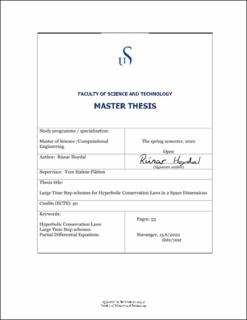| dc.description.abstract | Numerical solutions to partial differential equations (PDEs) will create varying amounts of error depending on different factors such as the numerical scheme and how fine the grid size is. In this thesis, we explored two different methods of discretizing a two dimensional domain in order to reduce this error. We compared the numerical error created from a rectangular- and a hexagonal- grid by using a specific type of PDE namely hyperbolic conservation laws. To this end, we used an explicit finite volume method not limited by the Courant-Friedrichs-Lewy (CFL) condition. This method is referred to as a Large Time Step (LTS) method and was proposed by LeVeque back in the 1980's. Since the two different grids are both what is called a structured grid, we were able to pair up the LTS method with a method called dimension splitting in order to both decrease the overall simulation time and increase the accuracy of the simulation. Combining those two methods we tested against two separate test cases for the flux. One was a linear flux while the other was a non-linear flux, namely a rotational flux around a center point. We found that for the linear flux, LTS was not strictly necessary in order to achieve an exact solution, however by utilizing LTS, an exact solution would be achievable for increasing amount of flux directions for both the rectangular and hexagonal grid. For the non- linear flux, no exact solution was found for any value of the Courant number (C), however we found that there exists an optimal value for C depending on the grid size which would minimize the numerical error. This value was clearly larger than 1 meaning that LTS is needed in order to achieve minimal numerical error on a rotational flux. The results showed that a rectangular grid was better suited in order to handle linear flux as it is able to capture a wider range of flux directions with an exact solution for all values of C. As for the non-linear flux, the two grids seems to be about even in terms of numerical accuracy. | |
